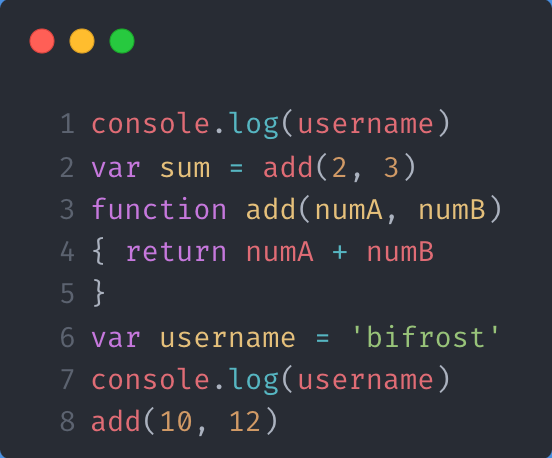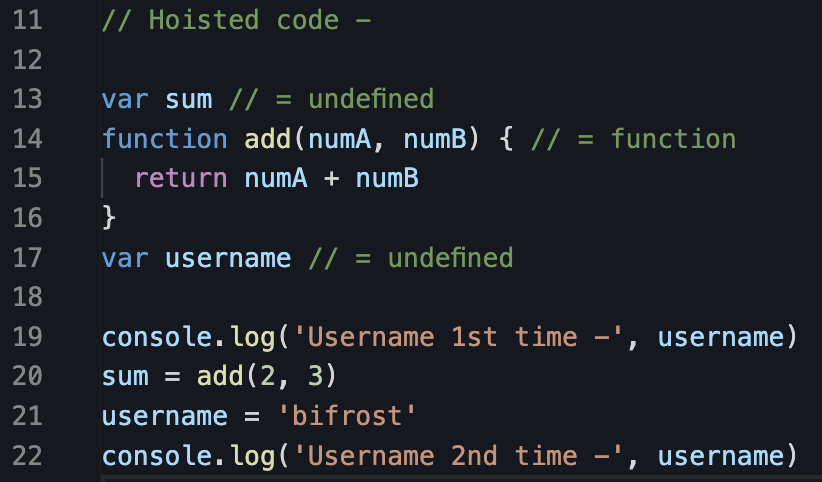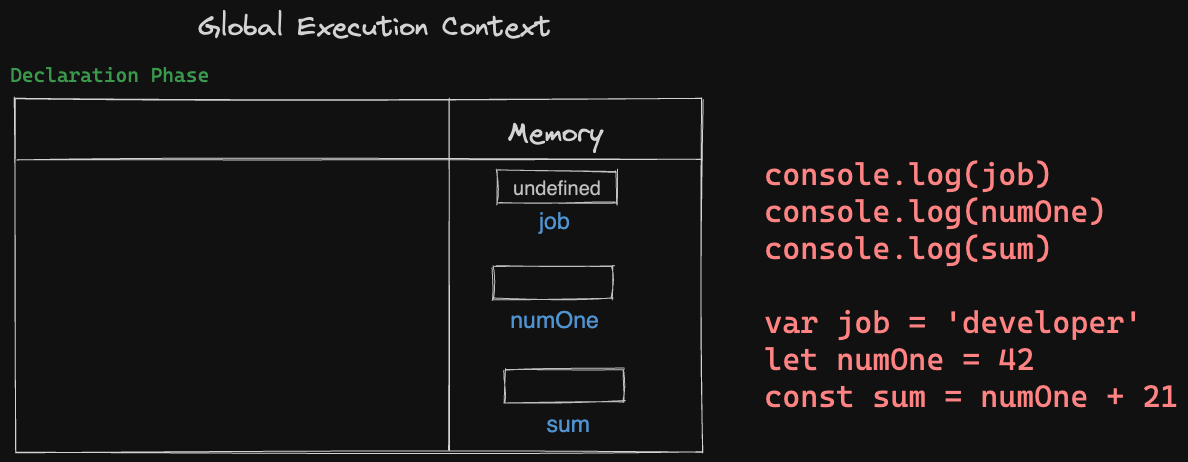Before we define Hoisting, you should know that we have already seen Hoisting in action in our previous article and code snippets, and you would probably be writing code every day that implements Hoisting without consciously being aware of it! It is a very tricky concept, one that is simple enough in practice but takes some time to wrap our heads around, given the idiosyncrasies of JavaScript 😃
Let’s do a quick recap by examining the code below -

As we know from our previous post on Execution Context, we have two phases of code execution - Declaration Phase and Execution Phase. According to that flow -
-
In line 1 of above code,
console.log()is a function call with the variableusername- and since it is a function call, it will be skipped, and the Execution Context goes to line 2, where variablesumis assigned the result of the function calladd(2,3). So within the Memory of the Global Execution Context, the variablesumis instantiated, with the initial value beingundefined -
Next, we have the function
add(numA, numB)- soaddis defined in the Memory, but it is notundefinedlike a variable is. Instead, in the Declaration Phase, variable declaration and function declaration are different in this manner. Variables are initiated with the initial valueundefinedwhereas function variables likeadd()in the above code, are initiated as functions - the Execution Context knows that function variables need to be initiated as functions. -
Moving on to line 6,
usernameis a variable that gets initiated withundefinedagain. -
Line 7 again has the
console.log()function that callsusernamevariable, so it is skipped for now. -
Finally in line 8, we have a function call
add(10,12)that is skipped for the Declaration Phase.
The execution flow changes from Declaration to Execution phase, and now the flow is like this -
-
Since line 1 is a function call for
console.log(), a Function Execution Context is created forconsole.log(). The value for username is not found in this execution context, so it bubbles out to find it in the parent memory, which is Global EC. Here, the value is found to beundefinedand so theconsole.log()outputs it as such. The Function EC forconsole.log()is then deleted. -
Moving on, now the variable
sumlooks for its value - which is the return value of the functionadd(2, 3). As usual, a function execution context (EC) gets created foradd(). How? Because earlier, we saw that function variables are initiated as functions in the declaration phase, unlike normal variables which get initiated asundefined. Now in the Declaration phase for this particular EC foradd(2,3), it immediately knows thatadd()is a function. And they have the variablesnumAandnumB- both of which get initiated asundefined. Now that declaration phase is over, execution phase begins, and bothnumAandnumBget the values 2 and 3 respectively - since those are what the arguments are during the function call. It performs that return statement which 2 + 3 - the result 5 is finally stored as the value for the variablesumin the GEC’s memory and this FEC gets deleted immediately. -
Next, in line 6, the variable
usernameis assigned the value ‘bifrost’, so its previous value ofundefinedchanges tobifrostnow. -
In line 7, the
console.log(username)function has the value forusername, so it logsbifrostto the console. -
Finally in line 8,
add(10,12)will return the relevant value since the function has already been declared before, and only the variable values are changed now - previously they were 2 and 3, now they are 10 and 12.
Observe something very crucial here - in line numbers 1 and 2, we are calling a variable and a function that have not even been declared yet. And still, we do not run into errors. How? This is possible due to Hoisting.
What is Hoisting?
As the word suggests, it is a concept where variables and functions are “hoisted” up in the flow of execution so that they can be called/invoked even before they are actually declared. And as mentioned earlier, it is not a new concept again, but an existing one which we have already defined and seen in practice - the Declaration Phase in Execution Context.
Because of this Declaration Phase where variables and functions are initiated with their respective values (variables as undefined and function variables as functions), the JavaScript engine knows that these values already exist, and hence does not throw any error.
That is it. That is all Hoisting is.
Proof? Here you go -

In the snippet below, notice how, the console.log() for line number 1 already logs a statement with the value undefined.

By the time the flow is deeper into the code, and we arrive at line number 8, username now has the value assigned as bifrost and hence displays the same instead of undefined.
Notice how for the variable assignment sum - which is a function call of add() - it does not throw an error that the variable/function is not defined. Instead, since EC already knows that sum is a function variable, it waits for the function declaration also to happen later on, and then returns the value to be assigned to sum and then logs it to the console.
In practice, this is how the variables are hoisted by the JS Engine -

Lines 13 - 17 represent declaration phase and lines 19 - 22 represent execution phase.
But.. we aren’t done yet
Notice how the variable username was declared with var throughout our previous article and this one too - and it was intentional, because there is a subtle difference in how var, let, and const create variables.
The entire premise of using modern ES6 syntax to write our web applications, is to remove inconsistencies and weed out possible bugs/errors during development phase. How so?
As we saw above, functions with the keyword function and variables with var can be called before declaring them. This is because in both these cases, the functions/variables are initialised either with undefined (for variables), or as functions for function variables - and hence can be accessed later on. This can seem beneficial for haphazard coding, but in the real world (production), this can lead to huge unintended errors.
Take this small example -

-
As we can see,
cartItemsis declared withvarin line 5 - but it is already being accessed in line 1. Still, there are no errors, and as usual, it would be initiated withundefined- making it possible to be accessed before it is declared. -
We have an
ifblock that checks for thetruthyorfalsystate ofcartItemsand then, only if found to befalsy, we want thedeleteCart()function to be invoked. -
Now the problem arises - in line 5, we declare
cartItemsas 10 but still, thedeleteCart()function is invoked and the damage, so to speak, is done. The cart items are deleted. -
Only in line 10, do we see that finally when the execution context has moved out of the declaration phase, and into the execution phase, the value of cart items is updated from
undefinedto 10.
Why does the above scenario happen? Hoisting.
Function declarations with the keyword function and variables with var are both hoisted and this can and will lead to bad errors in a huge application.
But what happens to variables with let and const? Welcome to Temporal Dead Zone.
Temporal Dead Zone
let and const variables are not initialised during Declaration Phase. They do not get an undefined or anything of the sort when they are created. Instead, from the beginning of the flow of execution right until the time of their declaration, let and const variables are said to be in a zone often called the Temporal Dead Zone.
Well, it may sound ominous and eerie, but it does suit the state and situation of the variables perfectly. A small illustration -

As can be seen, the variable job declared with var has been initiated to undefined but the variables numOne and sum declared with let and const respectively, are both empty “boxes”. And when it comes to execution phase, we get the console statement for job but not for the other two variables. In fact, the execution stops as soon as it encounters the second console statement, since it cannot find the initialisation for numOne and hence, it terminates the execution flow with the error message - Error: Cannot access 'numOne' before initialisation -

This behavioural difference holds true for Function Declarations vs Function Expressions as well.
Simply put - Function Declarations are hoisted, while Function Expressions and Arrow Functions are not. Like so -

Here, add() is a function declared with var so it hoisted and no errors are found. But when it comes to subtract(), it a function expression that is assigned to the variable sub - and even though it is declared with var, it it still an expression, so it does not get hoisted/initialised. The execution stops here with an error message.
Same is the case with multiply() - with a different error message like so -

Here, we can clearly see that from the error message, the `multiply` variable declared with let, is a function expression and therefore has not been initialised at all.
Closing Notes
All of this is a solid showcase of why we need best practices, and why we must adhere to it in “strict” mode while writing real world code. To summarise -
-
Use
letandconsteverywhere. Usingvaris outdated, and unnecessary in almost all modern use cases. -
Always, always declare variables and functions before using/invoking them.
-
Again, use
constfor all function expressions. -
You cannot prevent Hoisting from happening, but can certainly control when and where you would need it.
We have almost made it through the muddy waters - these behind the scenes functionalities and concepts are building blocks for what’s ahead - but for now, maybe a small celebratory dance is in order?

Or not 😃
See you in the next one! Until then,
Keep shipping 🚀
